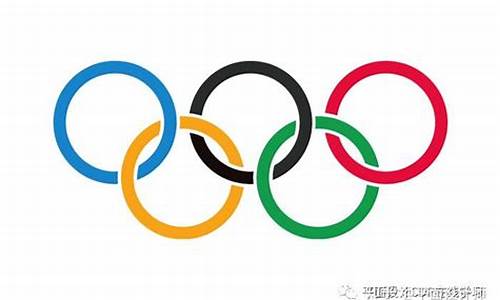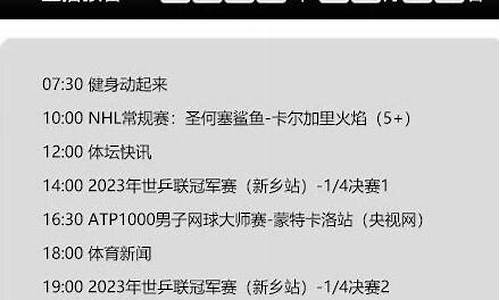1.奥运英语知识(有中文翻译)
2.仁爱英语八年级上册23页1a翻译
3.奥运五环颜色分别代表什么?用英语说哦!
4.奥运五环的由来(有英语,还有解释)

Olympic banner of five different colors of the ring :on behalf of the European blue, yellow on behalf of the Asian, black African representatives, on behalf of the Australian grass green, red and representatives of the Americas) connected together symbol of the unity of the five continents, representing the world's athletes in a fair and frank The friendly competition and the spirit of the Olympic Games on friendly each other, gathered together to promote the development of the Olympic movement
奥运英语知识(有中文翻译)
奥运五环分别代表:欧洲(天蓝色)亚洲(**)、非洲(黑色)、澳洲(草绿色)、美洲(红色)。象征着五大洲的友谊和团结。
1.简介:
奥林匹克运动会(希腊语:Ολυμπιακο? Αγ?νε?;法语:Jeux olympiques;英语:Olympic Games)简称“奥运会”,是国际奥林匹克委员会主办的世界规模最大的综合性运动会,每四年一届,会期不超过16日,是目前世界上影响力最大的体育盛会之一。
2.起源和发展:
奥林匹克运动会发源于两千多年前的古希腊,因举办地在奥林匹亚而得名。古代奥林匹克运动会停办了1500年之后,法国人顾拜旦于19世纪末提出举办现代奥林匹克运动会的倡议。1894年成立奥委会,1896年举办了首届奥运会,1924年举办了首届冬奥会,1960年举办了首届残奥会,2010年举办了首届青奥会。
2017年7月,国际奥委会决定由法国巴黎承办2024年奥运会,由美国洛杉矶承办2028年奥运会。
仁爱英语八年级上册23页1a翻译
What do the Olympic rings mean?
The colours of the interlinked Olympic rings were chosen by the International Olympic Committee (IOC) , to represent the union of the 5 continents , Australia , Africa , America , Asia and Europe and further signify the meeting of the worlds athletes at the Olympic Games.
The plain white background of the Olympic flag is symbolic of peace throughout the games .
The five colours of the rings from left to right are blue, black and red across the top with yellow and green along the bottom , these colours may be found on most flags of the world and officially hold no other particular significance , although some believe each colour represents a particular continent.
Blue =Europe
Yellow =Asia
Black =Africa
Green =Australia
Red =America
The Olympic rings are the official trademark of the I.O.C.
奥运五环代表什么?
国际奥委会选择五个相连的圆环作为其标志,并选择了相应的色彩。五个圆环代表五大洲:大洋洲、非洲、美洲、亚洲和欧洲。更深一层的意思是代表着全世界的运动员都聚集在奥林匹克运动会上。
朴素的白色背景寓意着和平。
五种颜色从左到右分别是:上方三个蓝、黑、红,下方黄和绿。这五种颜色都为各国国旗上的常见颜色,而且没有被赋予特殊含义。但是也有人认为,这五种颜色分别代表着五大洲。
蓝 =欧洲
黄 =亚洲
黑 =非洲
绿 =大洋州
红 =美洲
奥运五环颜色分别代表什么?用英语说哦!
早上好~~~ 早上好~~~
以下是原文~
The modern Olympics started in Athens ,Greece in 1896 .I its motto is '' Faster ,higher,stronger''.
The Olympic rings are a symbol of Olympic games .There are five rings , and they stand for the five parts of the world .
The colors of the rings are blue ,yellow ,black ,green and red .You can find a least one of these colors in the flag of each country in the world .
下面是翻译~
现代奥林匹克运动会在1896年起源于希腊雅典。它的口号是“更高,更快,更强”。
奥运五环是奥林匹克的一种象征。它由五个圆环组成,代表了世界的五个部分。
这些圆环分别是蓝色,**,黑色,绿色 和红色。你能在世界上每个国家的国旗上找到至少一种这样的颜色。
如果对你有帮助,那就纳好吗~
he nice day ~
奥运五环的由来(有英语,还有解释)
Colourful Olympic Games five rings signs , the continent representing five respectively,\x0d\blue is Europe , \x0d\black is Africa , \x0d\red is America , \x0d\the yellow is Asia , \x0d\green is Australia.
The emblem of the Olympic Games is composed of five interlocking rings (blue, yellow, black, green, and red respectively) on a white field. This was originally designed in 1913 by Baron Pierre de Coubertin, the founder of the modern Olympic Games. Upon its initial introduction, de Coubertin stated the following in the August, 1913 edition of Revue Olympique:
The emblem chosen to illustrate and represent the world Congress of 1914 ...: five intertwined rings in different colours - blue, yellow, black, green, red - are placed on the white field of the paper. These five rings represent the five parts of the world which now are won over to Olympism and willing to accept healthy competition.
In his article published in the "Olympic Revue" the official magazine of the International Olympic Committee in November 1992, the American historian Robert Barney explains that the idea of the interlaced rings came to Pierre de Coubertin when he was in charge of the USA, an association founded by the union of a two French sports associations and until 1925, responsible for representing the International Olympic Committee in France: The emblem of the union was two interlaced rings (like the vesica piscis typical interlaced marriage rings) and originally the idea of Swiss psychiatrist Carl Jung because for him the ring meant continuity and the human being.[2]
The 1914 Congress had to be suspended due to the outbreak of World War I, but the emblem (and flag) were later adopted. They would first officially debut at the VIIth Olympiad in Antwerp, Belgium in 1920.
The emblem's popularity and widespread use began during the lead-up to the 1936 Summer Olympics in Berlin. Carl Diem, president of the Organizing Committee of the 1936 Summer Olympics, wanted to hold a torchbearers' ceremony in the stadium at Delphi, site of the famous oracle, where the Pythian Games were also held. For this reason he ordered construction of a milestone with the Olympic rings carved in the sides, and that a torchbearer should carry the flame along with an escort of three others from there to Berlin. The ceremony was celebrated but the stone was never removed. Later, two British authors Lynn and Gray Poole when visiting Delphi in the late 1950s saw the stone and reported in their "History of the Ancient Games" that the Olympic rings design came from ancient Greece. This has become known as "Carl Diem's Stone".[3] This created a myth that the symbol had an ancient Greek origin. The rings would subsequently be featured prominently in Nazi images in 1936 as part of an effort to glorify the Third Reich.
The current view of the International Olympic Committee is that the emblem "reinforces the idea" that the Olympic Movement is international and welcomes all countries of the world to join.[4] As can be read in the Olympic Charter, the Olympic symbol represents the union of the five continents and the meeting of athletes from throughout the world at the Olympic Games. However, no continent is represented by any specific ring. Though colourful explanations about the symbolism of the coloured rings exist, the only connection between the rings and the continents is that the number five refers to the number of continents. In this scheme, the Americas are viewed as a single continent, and Antarctica is omitted.
五环旗的诞生
1914年6月,国际奥委会在巴黎召开第十六届全会。全会闭幕的日子——6月23日,正好是顾拜旦在巴黎索邦第一次召集奥林匹克会议建议振兴古代奥运会的20周年纪念日。在奥林匹克运动诞生20年的喜庆之际,国际奥委会顾拜旦男爵向与会的委员们献上了自己的杰作——国际奥委会会旗,它由洁白的底色和蓝、黄、黑、绿、红的五色圆环组成的五环旗.
后来又将5 个不同颜色的圆环解释奥运五环,也称为奥林匹克环,从左至右为天蓝、黄、黑、绿、红五色。这个标志是第一届现代奥运会上,由顾拜旦提议设计的,起初的设计理念是它能够概括会员国国旗的颜色,但以后对这五种颜色又有其他的解释。19年国际奥委会出版的《奥林匹克评论》(第四十期)强调,五环的含义是“象征五大洲的团结,全世界的运动员以公正、坦率的比赛和友好的精神,在奥运会上相见”。 为五大洲的象征.
奥运五环的来历
说起五环的来历,曾经有过这样一个有趣的故事。 1936年第11届柏林奥运会第一次举行火炬传递活动,火炬的传递路线自奥林匹亚开始,从希腊北部出境,沿多瑙河穿过奥地利,最后进入德国。为了烘托这一具有象征意义的活动,奥运会组委会卡尔·迪姆及其同事几乎完全按照古奥运会的情景来布置沿途经过的古希腊遗址。火炬到达德尔菲帕那萨斯山的古代运动场时要举行一个特别仪式,这时,迪姆突发奇想,在一个高约3英尺的长方形石头的四面设计并刻上了现代奥林匹克运动的五环标志,放在了古运动场的起跑线一端。仪式结束后,火炬继续北上,而这块作为道具的石头却被留在了古运动场。
由于极少有人知道这块刻有五环标志石头(后被称做“迪姆之石”)的真实身份,此后的很长一段时间,它被当做了“有3000年历史的古代奥运会遗迹”。这个以讹传讹的错误直到20世纪60年代才被德尔菲的希腊官员指出。12年5月,这个文物被送到德尔菲的另一个地方——古罗马广场入口处。
事实上,现代奥林匹克运动的五环标志出自现代奥运会创始人顾拜旦之手。顾拜旦认为奥林匹克运动应该有自己的标志,这个念头在他的脑海里盘桓已久。1913年,他终于构思设计了五环标志和以白色为底印有五环的奥林匹克旗,打算在国际奥委会成立20周年之际推出这个标志。
19 年6 月,国际奥委会正式宣布了会旗和五环的含义:根据《奥林匹克宪章》,奥林匹克旗帜和5 个圆环的含义是:象征五大洲的团结以及全世界运动员以公正、坦率的比赛和友好的精神在奥运会上相见。








